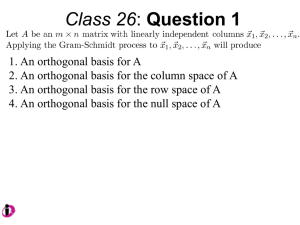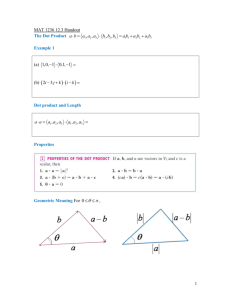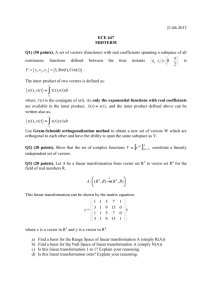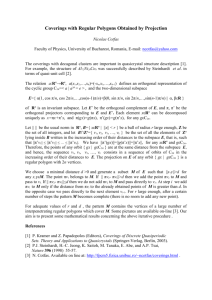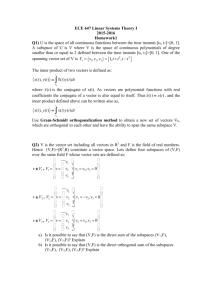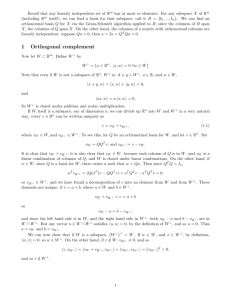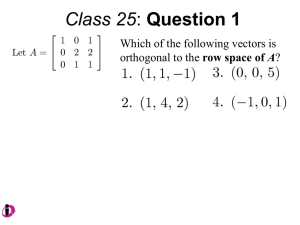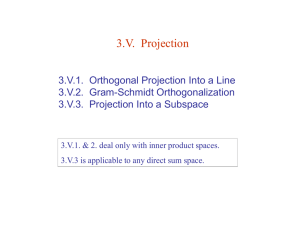Lec 33: Orthogonal complements and projections. Let S be a set of
advertisement
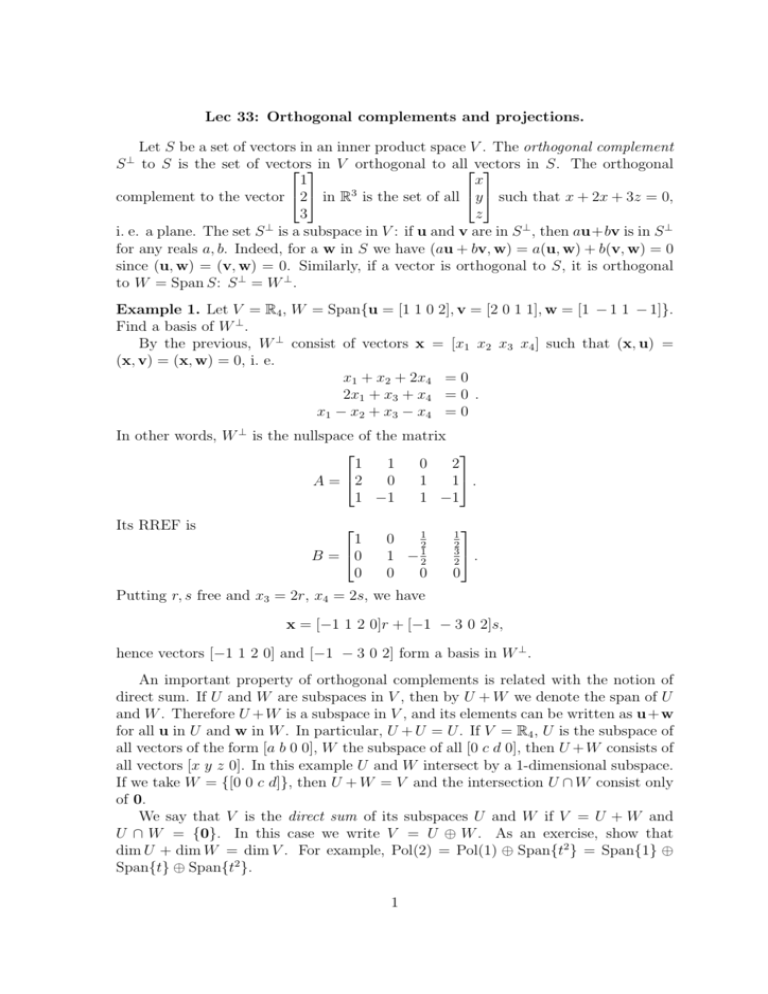
Lec 33: Orthogonal complements and projections.
Let S be a set of vectors in an inner product space V . The orthogonal complement
S ⊥ to S is the set of vectors
in S. The orthogonal
in V orthogonal to allvectors
1
x
complement to the vector 2 in R3 is the set of all y such that x + 2x + 3z = 0,
3
z
⊥
i. e. a plane. The set S is a subspace in V : if u and v are in S ⊥ , then au+bv is in S ⊥
for any reals a, b. Indeed, for a w in S we have (au + bv, w) = a(u, w) + b(v, w) = 0
since (u, w) = (v, w) = 0. Similarly, if a vector is orthogonal to S, it is orthogonal
to W = Span S: S ⊥ = W ⊥ .
Example 1. Let V = R4 , W = Span{u = [1 1 0 2], v = [2 0 1 1], w = [1 − 1 1 − 1]}.
Find a basis of W ⊥ .
By the previous, W ⊥ consist of vectors x = [x1 x2 x3 x4 ] such that (x, u) =
(x, v) = (x, w) = 0, i. e.
x1 + x2 + 2x4 = 0
2x1 + x3 + x4 = 0 .
x1 − x 2 + x3 − x4 = 0
In other words, W ⊥ is the nullspace of the matrix
1
1
0
2
0
1
1 .
A = 2
1 −1
1 −1
Its RREF is
1
B = 0
0
1
0
2
1 − 12
0
0
1
2
3
.
2
0
Putting r, s free and x3 = 2r, x4 = 2s, we have
x = [−1 1 2 0]r + [−1 − 3 0 2]s,
hence vectors [−1 1 2 0] and [−1 − 3 0 2] form a basis in W ⊥ .
An important property of orthogonal complements is related with the notion of
direct sum. If U and W are subspaces in V , then by U + W we denote the span of U
and W . Therefore U +W is a subspace in V , and its elements can be written as u+w
for all u in U and w in W . In particular, U + U = U . If V = R4 , U is the subspace of
all vectors of the form [a b 0 0], W the subspace of all [0 c d 0], then U + W consists of
all vectors [x y z 0]. In this example U and W intersect by a 1-dimensional subspace.
If we take W = {[0 0 c d]}, then U + W = V and the intersection U ∩ W consist only
of 0.
We say that V is the direct sum of its subspaces U and W if V = U + W and
U ∩ W = {0}. In this case we write V = U ⊕ W . As an exercise, show that
dim U + dim W = dim V . For example, Pol(2) = Pol(1) ⊕ Span{t2 } = Span{1} ⊕
Span{t} ⊕ Span{t2 }.
1
Theorem. For any subspace U in an inner product space V holds V = U ⊕ U ⊥ .
Proof. Show that U ∩ U ⊥ = {0}. If u belongs to both U and U ⊥ , then (u, u) = 0
which implies u = 0 by the definition of inner product.
Now denote W = U + U ⊥ and prove W = V . We can choose an orthonormal basis
in W and extend it to orthonormal basis in V . Thus, if W 6= V , there is an element
e in the basis of V orthogonal to W . Since W contains U , e is orthogonal to U as
well, which means e belongs to U ⊥ . The latter is a subspace of W , therefore e is in
W , and we arrive at contradiction with choice of e.
By the theorem, any vector v in V can be uniquely (why?) represented as u + w,
where u ∈ U , w ∈ U ⊥ . Then vector u is called the projection of v onto U , and we
denote it by projU v. In V = R2 regarded as plane, let U be the x-line. Then U ⊥ is
y-line and the projection of (x, y) on U is (x, 0).
Projection can also be characterized by the following property: u = projU v is the
closest to v vector in U . By being closest we mean the distance ku − vk is as small as
possible. [For the proof see the theorem on p.343 of the book.] We call kv − projU vk
the distance between v and U . Given an orthonormal basis S = {e1 , . . . , ek } in
U , we have u = (u, e1 )e1 + · · · + (u, ek )ek . Now note that (u, ei ) = (v, ei ) since
v = u + w and w is orthogonal to U . Thus we have a simple formula for computing
the projection:
projU v = (v, e1 )e1 + (v, e2 )e2 + · · · + (v, ek )ek .
1
3
Example 2. Let V = R , U the orthogonal complement to 2 .
−5
(a) Find a basis of U ;
(b) Find an orthonormal basis of U ;
3
(c) Find the distance between v = 1 and U .
7
x
Subspace U consists of all vectors y such that
z
x + 2y − 5z = 0.
Setting y = r, z = s free, we have x = −2r + 5s and
−2
5
x = 1 r + 0 s.
0
1
2
−2
5
Hence vectors u1 = 1 and u2 = 0 are a basis of U .
0
1
−2
Now find an orthonormal basis {e1 , e2 } of U . Take e1 = ku11 k u1 = √15 1 to
0
satisfy ke1 k = 1. Let’s find e2 in the form au1 + bu2 . Coefficients a, b can be found
from the conditions we want from e2 : (e2 , e1 ) = 0 (or
equivalently (e2 , u1 ) = 0) and
1
(e2 , e2 ) = 0. Solving this (do it!) we find e2 = √16 2 (or the negative). This finishes
1
(b).
In order to find the distance form v to U , we have to find the projection u =
projU v. As soon as we’ve found an orthonormal basis {e1 , e2 } in U , we can use the
formula:
4
√
√
u = (v, e1 )e1 + (v, e2 )e2 = − 5e1 + 2 6e2 = 3 .
2
−1
We have w = v − u = −2 and the distance
5
kv − uk = kwk =
√
30.
R1
Exercise Let V = Pol(2) with the inner product (p, q) = 0 p(t)q(t)dt. Find the
approximation of t2 by a linear polynomial. [In other words, find the projection of t2
on the subspace Pol(1).] (Answer: t − 61 ) What is the distance between t2 and Pol(1)?
Homework # 6 (due 23 November)
1. Section 5.3 p. 317 Exercise 3.
2. Section 5.3 p. 319 Exercise 36(a).
3. Section 5.3 p. 319 Exercise 45. (See p.311 for the definition of positive definite).
4. Section 5.5 p. 348 Exercise 7.
5. Section 5.5 p. 349 Exercise 16.
6. Section 6.1 p.372 Exercise 1.
7. Section 6.2 p.387 Exercise 3.
3

